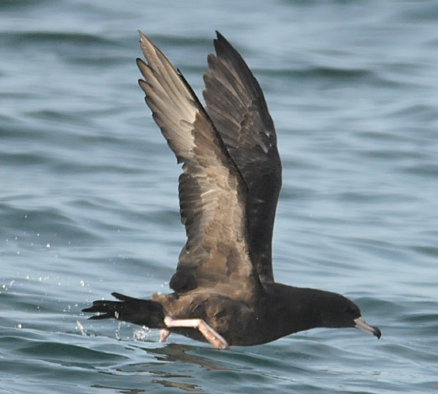
On first sight, what most people notice about Black Guillemots in their summer plumage are their bright red legs. The species could easily be called “Red-legged Guillemot” – were there not two other species in the guillemot genus Cepphus with red legs.
There are many good reasons to incorporate a field mark (a visible characteristic that can be used to identify a bird or other animal) in the common name of a species. When first hearing of the Red-tailed Hawk, one can visualize the species in a way not possible when first hearing about the Marsh Hawk. A field mark in the common name is especially helpful when two species have, as their primary difference, an obvious field mark. On hearing their names, we instantly know a major difference between the Black-legged Kittiwake and Red-legged Kittiwake, in a way we would not if they were called Common Kittiwake and Beringian Kittiwake.
The colorful characteristics of birds, as a group, play a major role in their ability to capture the attention and appreciation of humans. Descriptions of the variations in the color of plumage and soft parts allow birders and researchers to not just identify species but also determine gender, age and life-history stage while viewing birds at a distance with binoculars.
I had an interesting experience with ornithological color terminology in early 1969, when I had the opportunity to lead inner-city elementary school children on nature walks. In assessing the bird species we were likely to see and determining the field marks I should point out to the students, I realized that pinkish-beige legs or bills were described in the field guide as being “flesh-colored” – the reference clearly being to Caucasian skin color. It was clear to me that using this terminology would be inappropriate and insulting to a mixed-race group of students, and unproductive in my attempt to instill in them an appreciation of nature.
Many societal changes were occurring in the United States in the 1960s; and recognizing and addressing systemic racism was probably the most important. My realization that some of the color descriptions used by the major field guide of the time were both offensive and exclusionary, caused me to write its author, Roger Tory Peterson, to express my concerns. I was glad he took the time to reply, but disappointed in his response indicating he found nothing wrong with the terminology, in part because so few of the bird-watching community were people of color.
The activities and discussion inspired by this spring’s Black Lives Matter movement caused me to think back to my experience half a century ago. I wondered if the use of “flesh” as an avian color descriptor had been addressed or reduced. It turns out it has not. A Google search showed the term “flesh” is pervasive in describing pinkish-beige coloring in birds. I also realized that, as a seabird biologist, I had commonly read about the southern hemisphere seabird, the Flesh-footed Shearwater (Ardenna carneipes), without thinking about the implications of the common name for that bird.
In a post this June to the listserv of the Pacific Seabird Group, an organization I helped found in 1972, I mentioned my 1969 experience, and suggested the time had come for the name of Flesh-footed Shearwater to be changed. The post and the ensuing discussion had a number of results. A proposal has been submitted by Alvaro Jaramillo, a biologist with the San Francisco Bird Observatory and educator/guide, to the American Ornithological Society’s North American Classification Committee to have the name of Ardenna carneipes changed, likely to Pale-footed Shearwater. And eBird is apparently in the process of replacing the term “flesh” in its species descriptions as well.
The discussion of this matter made me curious about the origins and duration of our culture’s misuse of the term “flesh-colored.” I realized that one of my favorite radio shows to listen to on Cooper Island, A Way with Words, might provide some insight. I emailed them, the hosts of the show found it interesting that ornithologists were addressing the issue of racist terminology and nomenclature, and they invited me to call in to discuss the issue. Their research revealed the well-established and overtly inappropriate nature of the term. For instance, The Century Dictionary, first published in 1889, defined “flesh-colored” as being “the normal color of the skin of a white person; pale carnation or pinkish; the color of the cheek of a healthy white child”. You can listen to the discussion, which was recorded shortly before I left for the field, at this link.
The misuse the word “flesh” as a color descriptor in ornithology is a good example of the culture signaling that white lives matter more than Black lives and I want to thank those who responded to my concerns about this issue, especially to Alvaro Jaramillo, who took the initiative to write a proposal for a name change for Ardenna carneipes.
